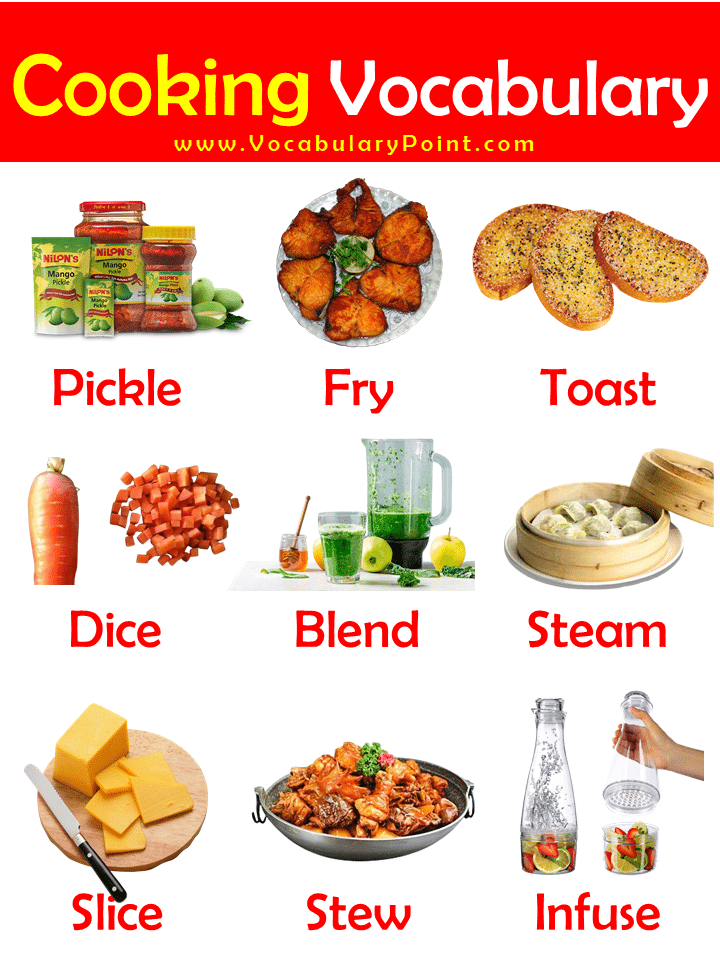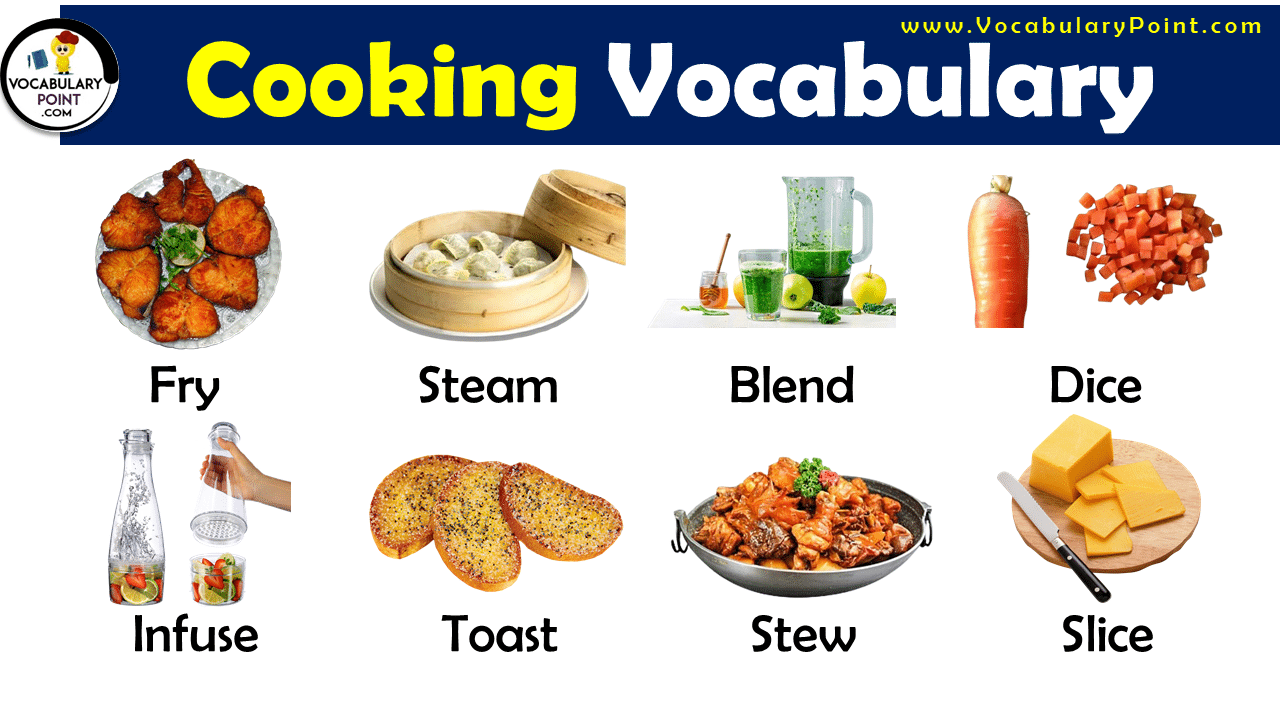Cooking Vocabulary is not just a collection of words; it’s the secret ingredient that turns simple ingredients into delicious dishes. Whether you’re a beginner just starting to explore the kitchen or a student looking to sharpen your English skills, understanding these terms can transform how you cook and talk about food.
This post is tailored especially for English learners, kids, and students eager to expand their culinary and language horizons. So, let’s embark on this flavorful adventure together, learning the language of cooking one step at a time.
Cooking Vocabulary
- Bake
- Boil
- Saute
- Fry
- Grill
- Roast
- Steam
- Simmer
- Broil
- Blend
- Chop
- Dice
- Slice
- Julienne
- Mince
- Knead
- Whisk
- Stir
- Fold
- Beat
- Glaze
- Marinate
- Garnish
- Season
- Peel
- Grate
- Shred
- Zest
- Squeeze
- Drizzle
- Poach
- Blanch
- Shock
- Braise
- Caramelize
- Char
- Clarify
- Core
- Cream
- Deglaze
- Devein
- Dredge
- Emulsify
- Ferment
- Fillet
- Flambé
- Foam
- Fond
- Infuse
- Macerate
- Mash
- Pan-fry
- Parboil
- Pickle
- Pit
- Plank
- Puree
- Reduce
- Refresh
- Render
- Rest
- Ribbon
- Roast
- Scald
- Scallop
- Score
- Sear
- Season
- Segment
- Shuck
- Sieve
- Skewer
- Skim
- Smoke
- Snip
- Sous-vide
- Sift
- Stew
- Stock
- Sweat
- Temper
- Tenderize
- Thicken
- Toast
- Toss
- Truss
- Whip
- Winnow
- Wrap
- Zest
- Bind
- Coddle
- Curdle
- Deep-fry
- Enrobe
- Fricassee
- Gnocchi
- Gratin
- Hull
- Larder
Explore More:

1. Bake
To cook food by surrounding it with hot, dry air, usually in an oven. This method is commonly used for bread, cakes, and pastries.
2. Boil
To heat a liquid until bubbles rise continuously and break on the surface, used for cooking pasta, vegetables, or making broths.
3. Saute
A cooking method where food is quickly fried in a small amount of oil or butter over relatively high heat, often used for vegetables or meat.
4. Fry
To cook food in hot fat or oil, usually until it becomes crisp and browned. It can be deep frying or shallow frying.
5. Grill
To cook food over direct heat, usually on a metal grate over charcoal or gas, imparting a distinctive charred flavor.
6. Roast
To cook food, typically meat or vegetables, in an oven or over a fire, allowing it to become browned or crispy on the outside.
7. Steam
To cook food by exposing it to steam, preserving its texture and nutrients. Often used for vegetables and seafood.
8. Simmer
To cook liquid just below the boiling point, with gentle bubbles forming. It’s ideal for soups, stews, and sauces.
9. Broil
To cook food with high heat from above, as in an oven’s broiler, often used to brown the top of a dish quickly.
10. Blend
To mix ingredients thoroughly until they become smooth, often using a blender. Used for soups, sauces, and smoothies.
11. Chop
To cut food into pieces with a knife, the size of the pieces can vary from rough chops to finely chopped.
12. Dice
To cut food into small, square pieces, usually about 1/4 to 1/8 inch on a side, often used for vegetables.
13. Slice
To cut food into thin, flat pieces. This technique is commonly used for fruits, vegetables, and meats.
14. Julienne
To cut food into thin, matchstick-sized strips. Commonly used for vegetables in salads or stir-fries.
15. Mince
To chop food into very small pieces, finer than chopping. Often used for garlic, herbs, or onions.
16. Knead
To work dough with the hands to develop gluten, making it elastic. Essential in bread and pastry making.
17. Whisk
To beat ingredients together with a whisk, incorporating air and making them smooth. Commonly used for eggs or batter.
18. Stir
To mix ingredients with a spoon or stick in a circular motion. It’s a basic technique for mixing or preventing sticking.
19. Fold
To gently combine a light, airy ingredient with a heavier one. It’s crucial in maintaining volume in mixtures like mousse.
20. Beat
To mix ingredients vigorously to incorporate air, making the mixture smooth and fluffy. Commonly used in batter and egg whites.
21. Glaze
To coat foods with a liquid that forms a glossy finish. Often used for meats, pastries, and desserts.
22. Marinate
To soak food in a flavorful liquid for a period of time to tenderize and add flavor. Common for meats and vegetables.
23. Garnish
To add decorative or flavorful elements to dishes before serving, enhancing both appearance and taste.
24. Season
To enhance the flavor of food by adding herbs, spices, salt, or other seasonings. It’s fundamental in cooking.
25. Peel
To remove the outer layer of fruits or vegetables, usually with a knife or a peeler.
26. Grate
To shred food into fine pieces using a grater. Commonly used for cheese, vegetables, and zest.
27. Shred
To cut food into thin strips, often using a grater or a food processor. Used for cabbage, cheese, and other vegetables.
28. Zest
To scrape or cut off the outer colored part of the peel of citrus fruits for flavoring.
29. Squeeze
To press firmly to extract juice or oil, commonly done with lemons, limes, or oranges.
30. Drizzle
To pour a liquid in a very thin stream over food, often used for sauces, melted chocolate, or oil.
31. Poach
To cook food gently in liquid just below the boiling point, keeping it tender. Often used for eggs, fish, and fruit.
32. Blanch
To briefly cook food in boiling water, then immediately cool it in ice water. Helps to preserve color and texture.
33. Shock
To stop the cooking process by quickly cooling blanched foods in ice water. It helps maintain vibrant color and texture.
34. Braise
To cook food slowly in a small amount of liquid in a covered pot, combining moist and dry heat cooking methods.
35. Caramelize
To heat sugar until it becomes a brown liquid, adding flavor. Also refers to browning of natural sugars in food.
36. Char
To cook food with a direct flame until it has a blackened exterior, adding a smoky flavor.
37. Clarify
To make a liquid clear by removing impurities, commonly done with butter or broth.
38. Core
To remove the central part of a fruit, which usually contains seeds.
39. Cream
To beat butter with sugar until light and fluffy, often the first step in making cookies or cakes.
40. Deglaze
To add liquid to a pan to loosen and dissolve the food particles that are stuck to the bottom.
41. Devein
To remove the dark vein from the back of shrimp, which is actually its digestive tract.
42. Dredge
To coat wet or moist foods with a dry ingredient before cooking to add texture and flavor.
43. Emulsify
To combine two liquids that normally don’t mix well, such as oil and vinegar, into a smooth mixture.
44. Ferment
To undergo a chemical change caused by enzymes, producing alcohol, gases, or acidic compounds. Used in bread making and brewing.
45. Fillet
To cut meat or fish from the bone, resulting in a boneless piece of meat or fish.
46. Flambé
To pour liquor over food and ignite it, creating a visual effect and enhancing flavor.
47. Foam
To create a light, airy mass by whipping liquid, often used for egg whites or cream.
48. Fond
The brown bits left in the pan after cooking, used to flavor sauces and gravies.
49. Infuse
To steep ingredients in liquid to extract the flavor, commonly used for herbs, tea, or spices.
50. Macerate
To soak fruit or vegetables in liquid to soften and develop flavor, often used in preparing fruits for desserts.
